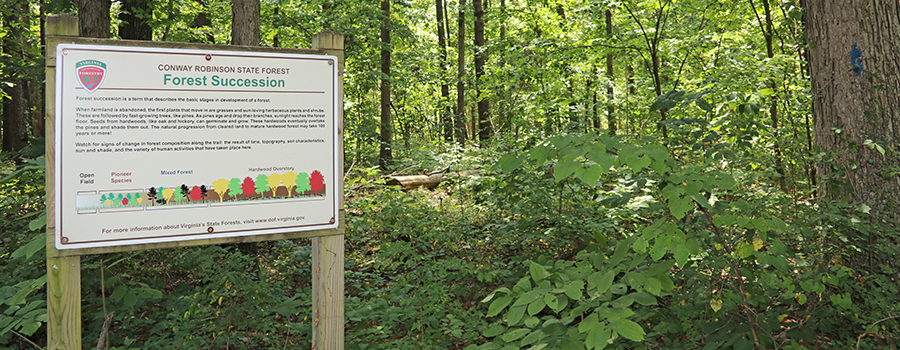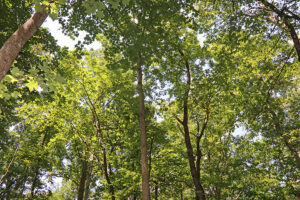
Overview
Conway Robinson State Forest, located in Prince William County, is a 440-acre woodland oasis in a heavily-developed suburban area. Management focuses on demonstration of scientific forest management, research, wildlife habitat, watershed protection, biological diversity, and outdoor recreation. The forest provides a fascinating blend of mature and immature hardwoods, pine plantations, prehistoric and historic sites, rare plants, and attractive wildflowers. Some individual mature oak trees are more than 250 years old, dating back to the site’s earliest settlement and cultivation in small farms.
Several intermittent and perennial streams are found on the property, and Little Bull Run bounds the forest on the north. A rock outcrop overlooking Little Bull Run may have provided shelter to Native Americans. Manassas National Battlefield Park (Civil War) is located about a mile east of the forest.
State law requires that visitors carry a copy of a negative Coggins test report with each horse on state lands.
At a Glance
Access Status: Open to the Public
Hours: Open daily from dawn until dusk
Physical Address:
Latitude/Longitude:
38° 48′ 10.6″, -77° 35′ 11.9″
Parking/Access: Access via the north side Route 29, slightly more than a mile west of the Manassas National Battlefield Park, and 1,500 feet east of the intersection of Route 29 with Interstate Route 66
Parking is available at the main entrance on Route 29.
Restroom Facilities: None
Visitors are asked to adopt a “leave-no-trace” ethic when visiting the forest, as there are no restrooms or trash cans on the forest itself.
Other Facilities: 1 Picnic Shelter
Seasonal Closures: The forest may occasionally close for regulated lottery hunts.
VDOF recommends that all forest visitors wear blaze orange or pink during hunting seasons.
The property became a state forest in 1938, deeded by the Conway Robinson Memorial Park Association in memory of the late Conway Robinson. There was considerable reluctance in accepting the property, due to the belief that no one would ever use it. At the time of the gift, Lee Highway (Route 29) was a single-track dirt road that was difficult to traverse, particularly in wet weather. Now, the area is one of the highest populated areas in Virginia.
In the 1930’s, a Civilian Conservation Corp (CCC) camp was located on the site of the current parking area. Members of the CCC crew planted the first trees on the property.
Historical Landmarks
An abandoned railroad bed on the forest was part of the uncompleted Manassas Gap Railroad, originally planned as a route from Gainesville to Alexandria.
The Conway Robinson State Forest provides opportunities for a variety of development activities to enhance its timber and multiple-use values. The loblolly pine stands are being harvested over time, with consideration given to reforesting with shortleaf pine, a diminished species in Virginia.
The mature upland hardwood stands are generally left to grow unless a forest health problem necessitates removal. Stands are monitored to keep them in good health.
Rare and Endangered Species
Although not endangered, two notable plant species have been identified on site, Virginia bluebells and large-flowered trillium.
Recreational uses of the Conway Robinson State Forest include hiking, biking, horseback riding, and wildlife watching. Hiking is the most common recreational use.
Visitors are asked to adopt a “leave-no-trace” ethic when visiting the forest, as there are no restrooms or trash cans on the forest itself.
ATV/ORV use, camping, and swimming are prohibited on all State Forests.
A State Forest Use Permit* is required for individuals aged 16 and older to hunt, fish, trap, horseback ride, or mountain bike on state forest lands. The permit can be purchased online or where hunting licenses are sold.
Trails and Roads
- 5.1 miles of forest trails (no vehicles)
- 0.2. miles of forest roads (vehicles allowed)
- 1.2 miles of gated forest roads (no vehicles)
- No driving past forest gates.
Hiking
Hiking is permitted on trails and all forest roads.
Mountain Biking
Mountain biking is permitted on trails and all forest roads.
Horseback Riding
Horseback riding is permitted, but parking for horse trailers is limited.
State law requires that visitors carry a copy of a negative Coggins test report with each horse on state lands.
Hunting and Trapping
A lottery hunt is occasionally conducted. Hunting with lottery permit, valid State Forest Use Permit and valid hunting license in accordance with state regulations. Note that some regulations may be different than on private land, so check Virginia Department of Wildlife Resources Hunting Regulations for specific state forest details.
Read the Hunter Protocols before applying.
Apply here.
Other Recreational Opportunities
Other passive recreational opportunities, such as wildlife watching and nature photography, are available.
- Self-learning opportunities are available.
- Self-guided educational opportunities – interpretive signs.
Explore tree and wildlife identification, study rock formations, or simply observe nature. The forest demonstrates forest management, harvesting techniques, and best management practices to landowners, loggers, and industry professionals.
Local schools can use the state forest for educational purposes.
For more information or questions, e-mail us or use our contact form.
State Forest Main Office
Located at Cumberland State Forest
751 Oak Hill Road, Cumberland, VA 23040-2511
E-mail | (804) 492-4121



